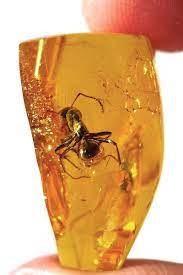
Amber with inclusion - Baltic ant (Anders L. Damgaard, 2010)
This story then prompted me to have a look at the amber gemstone as to what the fuss (if any) was all about. According to Tim Matthews at Gemstones (2023) amber is one of the older organic gemstones as it derives from now extinct coniferous trees. This means that amber is strictly speaking, not a gemstone. Grimaldi, in Science magazine (2009) said that amber is fossilised tree resin and its sticky constituency means insects can be found within the gemstone. These are known as inclusions and have a higher monetary value.Amber has been a sought-after gemstone since Neolithic times and in antiquity it was found in southern Italy, Sicily, Greece, the Middle East and Africa to name but a few places. Beck in his book on Minoan and Mycenaean amber shows that amber artefacts have been found in the ancient Mediterranean world in Sicily and mainland Greece. This indicates that there were extensive trade links and routes throughout these times.
According to Hood (1990) in a study on amber in archaeology, the breast ornament of Tutankhamun includes amber from the Baltic. Indeed, Baltic amber jewelry and artefacts have been found all over the Middle East including the Royal Tomb in Qatna Syria. Amber is believed to have been transported along the Silk Road into China and Mongolia during the Kitan Dynasty (916-1125AD). The implication is that trade in amber was extensive over thousands of years along ancient routes connecting the Baltic to southern Europe, Africa, the Middle East and as far as China.

the Amber Road routes (eRegion 2016)
The biggest deposits of amber are to be found in the Baltic area around Lithuania and Gdansk in Poland. The amber would originally have been collected from beaches after storms had disturbed the sea floor enabling local people to harvest the natural bounty. Indeed, Pliny the Elder mentions the Baltic area as a source of amber in his book Natural History. Trade routes known as the Amber Road were created to and from the Baltic via Transdanubia in Hungary to Aquileia in the Adriatic Sea by the Gulf of Venice. From Italy, amber would be transported to the wider Mediterranean and beyond. Amber in the Baltic area is now produced from mines in the Baltic Sea and North Sea as all the storm material seem to have been collected over the centuries.The Letslearnlang website (2023) comments that Amber derives from the Arabic word anbar which translated to mean yellow/brownish substance which had a sweet aroma. Over time anbar became amber which is associated with the golden yellow color of the gemstone. In Jewish culture the name Amber is linked with eternity as amber is one of the few substances that does not decay over time. In Christian traditions amber is synonymous with purity and in Muslim tradition amber is associated with good luck. In many cultures, amber is believed to have protective powers to ward off evil spirits hence its popularity as a form of jewelry. Letslearnlang comments that it is still used in aromatherapy and crystal healing for its calming effects on the human mind and body.Amber is popular today due to its natural beauty being compared to golden yellow sunshine and honey and is used in jewelry and decorative artefacts. It is also believed to protect against negative energies and improve and enhance positive energy and thoughts leading to happier behaviours and outlooks on life. All in all, amber seems as much sought after and revered today as it has ever been.Ant in Amber
Trapped. Caught in the golden
resin of a long dead pine,
held firmly in place, in
time, a honeyed window
to a long-forgotten past,
the ant could not break
free, perfectly preserved
for posterity, never to age
nor decay, embalmed in
nature’s own inimitable
way, for future generations
to gaze in awe at
amber’s ancient power.
Dermot Moroney 2023 Email ThisBlogThis!Share to TwitterShare to Facebook
